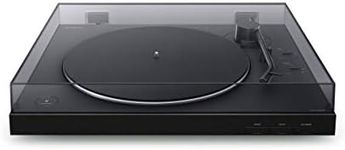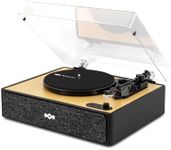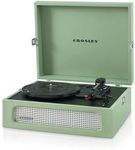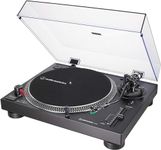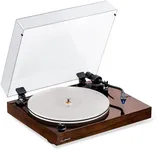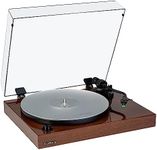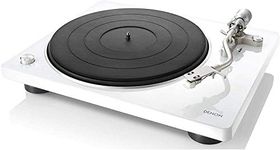Buying Guide for the Best Affordable Record Players
Choosing the right record player can be a delightful experience, especially if you're passionate about music and vinyl records. When selecting an affordable record player, it's important to consider several key specifications to ensure you get the best fit for your needs. Understanding these specs will help you make an informed decision and enjoy your vinyl collection to the fullest.Drive TypeThe drive type refers to how the platter (the part that holds the record) is powered. There are two main types: belt drive and direct drive. Belt drive record players use a belt to connect the motor to the platter, which can reduce vibrations and provide a smoother sound. Direct drive record players have the motor directly connected to the platter, offering more consistent speed and durability, which is ideal for DJs. If you're a casual listener, a belt drive might be preferable for its sound quality, while a direct drive is better for those who need precision and durability.
Cartridge and StylusThe cartridge and stylus are crucial components that read the grooves of the vinyl record. The cartridge holds the stylus, which is the needle that touches the record. There are different types of cartridges, such as moving magnet (MM) and moving coil (MC). MM cartridges are more common and affordable, providing good sound quality for most users. MC cartridges are typically more expensive and offer higher fidelity. For most users, an MM cartridge will be sufficient, but audiophiles might prefer an MC cartridge for the best sound quality.
Platter MaterialThe platter material can affect the sound quality and stability of the record player. Common materials include plastic, aluminum, and acrylic. Plastic platters are lightweight and affordable but may not provide the best sound quality. Aluminum platters are more durable and offer better sound stability. Acrylic platters are considered high-end and provide excellent sound quality and vibration dampening. If you're looking for an affordable option, aluminum platters are a good balance between cost and performance.
TonearmThe tonearm is the part of the record player that holds the cartridge and stylus and moves across the record. There are different types of tonearms, such as straight and S-shaped. Straight tonearms are simpler and often found on entry-level record players, while S-shaped tonearms are designed to reduce tracking errors and provide better sound quality. For most users, a straight tonearm will be sufficient, but if you're looking for better sound accuracy, an S-shaped tonearm might be worth considering.
Speed SettingsRecord players typically offer different speed settings to accommodate various types of vinyl records. The most common speeds are 33 1/3 RPM (for LPs) and 45 RPM (for singles). Some record players also offer 78 RPM for older records. It's important to choose a record player that supports the speeds of the records you own. If you have a diverse collection, look for a player with multiple speed settings to ensure compatibility with all your records.
Built-in PreampA built-in preamp amplifies the signal from the cartridge to a level that can be used by speakers or other audio equipment. Some record players come with a built-in preamp, while others require an external preamp. If you don't have an external preamp or want a simpler setup, choosing a record player with a built-in preamp can be convenient. However, external preamps can offer better sound quality and more customization options for audiophiles.
PortabilityPortability refers to how easy it is to move and transport the record player. Portable record players are typically smaller, lighter, and may have built-in speakers. They are ideal for casual listeners who want to take their music on the go or have limited space. However, portable record players may not offer the same sound quality as larger, more stationary models. If you plan to use your record player in one place, a stationary model might provide better performance.
